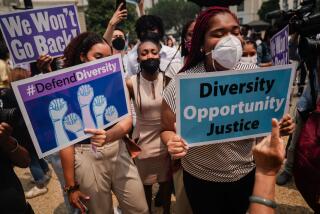The Means to Racial Justice Are Undone
- Share via
Over recent months, in a succession of decisions attacking affirmative action, the Supreme Court has been swiftly transforming itself into a bastion of racial bigotry. Ronald Reagan has retired to California in honored splendor, but his “revolution” against the oppressed appears to have found a home in Washington’s multimarbled chambers of justice.
Over the generation since the civil-rights movement began, blacks have seen the end of legalized segregation and won the right to vote. But the fight for economic justice has not been won. And now even the pitifully small gains of recent decades have been put in jeopardy by the cruel decisions of our highest tribunal--decisions drafted in some abstract chamber of the mind, shuttered from the realities of racial hostility and the long history of black oppression that Lyndon Johnson once referred to as the “original sin” of the American nation.
Economic justice is a resonant abstraction, but its meaning is grounded in the tangible, mundane strivings of the individual American--the right of all citizens to develop their abilities and put them to use in rewarding labor. We all know that large numbers of black Americans have been denied that right because they were black. The historical devastations and continuing racial hostilities that are the foundation of this injustice cannot be legislated away. But the right, at least in part, can be secured by law. Public and private employers can be required to give jobs to blacks, to provide them the equality of opportunity that belongs to every American. To accomplish this, it is not enough merely to prohibit discrimination. That is unworkable. And it is unnecessary. We all know that racial discrimination is a reality.
The concept of affirmative action is nothing more than a recognition of such reality, requiring businesses and governments to demonstrate their abandonment of discrimination by increasing the number of black employees. Results, not empty promises or paper policies, are the test--the means to determine whether equality is a fact.
As early as May, 1941, President Franklin D. Roosevelt wrote a memo to William Knudsen, head of the War Production Board, suggesting that defense industries be required to “take Negroes up to a certain percentage in factory order work.” And shortly thereafter the President set up the Fair Employment Practices Commission to prevent discrimination in employment. The onset of war and the immense leap in production seem to have made quotas unnecessary. But the suggestion was evidence of Roosevelt’s recognition that results were a necessary test of intention.
The return of peace brought an end to black progress. Then, in the early 1960s, at the command of Bull Connor, the notorious Birmingham, Ala., police chief, water cannons and electric cattle prods were used to disperse crowds of blacks peacefully demonstrating for their constitutional rights. Television brought the ugly sight of this official brutality into the homes of the nation, and a shocked public opinion allowed the hitherto reluctant Administration of John F. Kennedy to propose the most sweeping civil-rights legislation since reconstruction (“You’ve got Bull Connor to thank for this law,” Kennedy was later to tell a private meeting of civil rights leaders.) Title VII of this law prohibited discrimination in employment, the same act that has just been seriously crippled by the Supreme Court in a case coming, ironically, from Birmingham.
Enacted in 1964, the Kennedy Civil Rights Act was followed by the far more sweeping legislation of the Great Society. The concept of affirmative action as a means to enforcement was embraced by Kennedy, pursued with enormous vigor by Johnson and continued by Richard M. Nixon. And it worked. Not completely. Not enough. But more individual blacks were hired, more black businesses received public contracts.
Now, wiping out the precedence of almost two decades, the Supreme Court has said that it is no longer enough to show that the percentage of blacks employed is much smaller than those in the work force. It must also be proven that the disparity is a result of racial discrimination.
This imposes an almost impossible burden. Indeed, it makes a mockery of affirmative action and of common sense itself, since such disparities are almost certainly a consequence of past and present denials. But it is often hardest of all to prove that which we all know to be true. The court has also decided that agreements between civil- rights groups and municipalities to increase black employment, agreements then sanctioned by a judicial decree, can later be attacked by any white person who feels unfairly treated. Thus the incentive to make such agreements is, by edict of the justices, stripped away.
This particular case is the one from Birmingham, whose Fire Department has hired blacks pursuant to such an agreement for eight years. In all that time no one has complained that fires burned longer or more dangerously. The department is as efficient as it ever was. Some measure of integration was achieved. And now the court has undone the means used to achieve economic justice in this and hundreds of other places.
Indeed, the entire discussion of racial justice has taken on an ugly and mean-spirited tone. We no longer hear appeals to achieve equal opportunity, social justice and the elimination of bigotry. The new code words are phrases like “reverse discrimination,” “forced busing,” “arbitrary quotas.” This change in public dialogue manifests increasing indifference, even hostility, to the plight of the poor and dispossessed; it is a symptom of the widening gulf between the two societies--separate and unequal--which is not only an increasingly prominent feature of American life, but a denial of all that America means.
More to Read
Get the L.A. Times Politics newsletter
Deeply reported insights into legislation, politics and policy from Sacramento, Washington and beyond. In your inbox twice per week.
You may occasionally receive promotional content from the Los Angeles Times.










